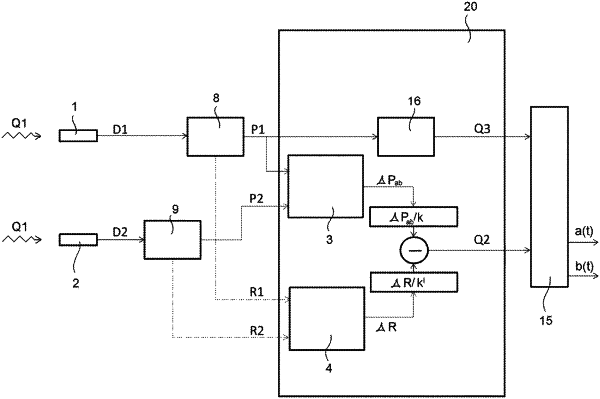| CPC H04B 10/118 (2013.01) [G02F 2/008 (2021.01); H04B 7/18515 (2013.01); H04B 10/11 (2013.01); H04B 10/541 (2013.01); H04J 14/02 (2013.01)] | 20 Claims |

|
1. A method for demultiplexing and demodulating amplitude-modulated signals grouped by means of multiplexing in an orbital angular momentum variable,
wherein a signal to be demultiplexed and demodulated comprises a composite electromagnetic radiation beam (Q1), consisting of a superposition of a reference beam (F0) and a main beam, in turn consisting of a superposition of a first modulated beam (Fm1) and at least one second modulated beam (Fm2);
wherein said first modulated beam (F1) is obtained by modulating a first piece of m1information, represented by a first modulation function a(t), on a first electromagnetic radiation beam (F1), by means of an amplitude modulation technique, and wherein said at least one second modulated beam (Fm2) is obtained by modulating at least one second piece of information, represented by a second modulation function b(t), on at least one respective second electromagnetic radiation beam (F2), by means of an amplitude modulation technique;
wherein said first electromagnetic radiation beam (F1) is characterized by a first orbital angular momentum (L1), and said at least one second electromagnetic radiation beam (F2) is characterized by at least one respective second orbital angular momentum (L2), wherein both the first electromagnetic radiation beam (F1) and the at least one second electromagnetic radiation beam (F2) have respective spectra in a same first frequency band, and furthermore have respective radii of curvature substantially coinciding with a first beam radius-of-curvature value,
and wherein said reference electromagnetic radiation beam (F0) is characterized by a second orbital angular momentum (L0), a second spectrum in a second frequency band which is distinct from said first frequency band, and a second beam radius of curvature having a value substantially coinciding with said first beam radius-of-curvature value;
wherein the method comprises the steps of:
passing said composite electromagnetic radiation beam (Q1) through two openings (Z1,Z2), so as to obtain, downstream of the first opening (Z1), a first composite beam portion (Q1(x1)) and, downstream of the second opening (Z2), a second composite beam portion (Q1(x2));
transmitting said first composite beam portion (Q1(x1)) along a first branch (A) of an interferometer (40) and said second composite beam portion (Q1(x2)) along a second branch (B) of the interferometer;
superimposing, by means of a beam splitter (41) of the interferometer, the first composite beam portion (Q1(x1)) and the second composite beam portion (Q1(x2)) along a third branch (D) of the interferometer, to obtain a respective third electromagnetic beam (D), and along a fourth branch of the interferometer (C), to obtain a respective fourth electromagnetic beam (C);
performing a frequency discrimination of the third electromagnetic beam (D) around said first frequency band, so as to obtain a third filtered electromagnetic beam (F) wherein the contributions deriving from the reference beams of the first composite beam portion (Q1(x1)) and of the second composite beam portion (Q1(x2)) have been canceled, and wherein the components deriving from the respective first modulated beam (Fm1(x1), Fm1(x2)) and at least one second modulated beam (Fm2(x1), Fm2(x2)) remain;
performing a frequency discrimination of the fourth electromagnetic beam (C) around said second frequency band of the reference beam, so as to obtain a fourth filtered electromagnetic beam (E) consisting of the superposition of the two reference beams (F0(x1), F0(x2)) belonging to the first composite beam portion (Q1(x1)) and the second composite beam portion (Q1(x2)), respectively;
detecting said third filtered electromagnetic beam (F), by means of a first beam detector (1), to generate a first electrical signal (V1), representative of an intensity of the electromagnetic radiation of the third filtered electromagnetic beam (F);
determining, based on said first electrical signal (V1), a first phase difference value (ΔPab) between the component of the third filtered electromagnetic beam deriving from the first composite beam filtered portion (Fm1(xI)), Fm2(x1)) and the component of the third electromagnetic beam deriving from the second composite beam filtered portion (Fm1(x2), Fm2(x2)), at the first beam detector (1), wherein said first phase difference value (ΔPab) is dependent on a value taken by the first modulation function a(t) and the second modulation function b(t);
detecting said fourth filtered electromagnetic beam (E), by means of a second beam detector (2), to generate a second electrical signal (V2), representative of an intensity of the electromagnetic radiation of the fourth filtered electromagnetic beam (E);
determining, based on said second electrical signal (V2), a second phase difference value (ΔR) between the two reference beams (F0(x1), F0(x2)) belonging to the first composite beam portion (Q1(x1)) and the second composite beam portion (Q1(x2)), at the second beam detector (2); and
demultiplexing and demodulating the information (a(t), b(t)) modulated on each of the first modulated beam (Fm1) and the at least one second modulated beam (Fm2), based on said first phase difference value (ΔPab) and second phase difference value (ΔR).
|